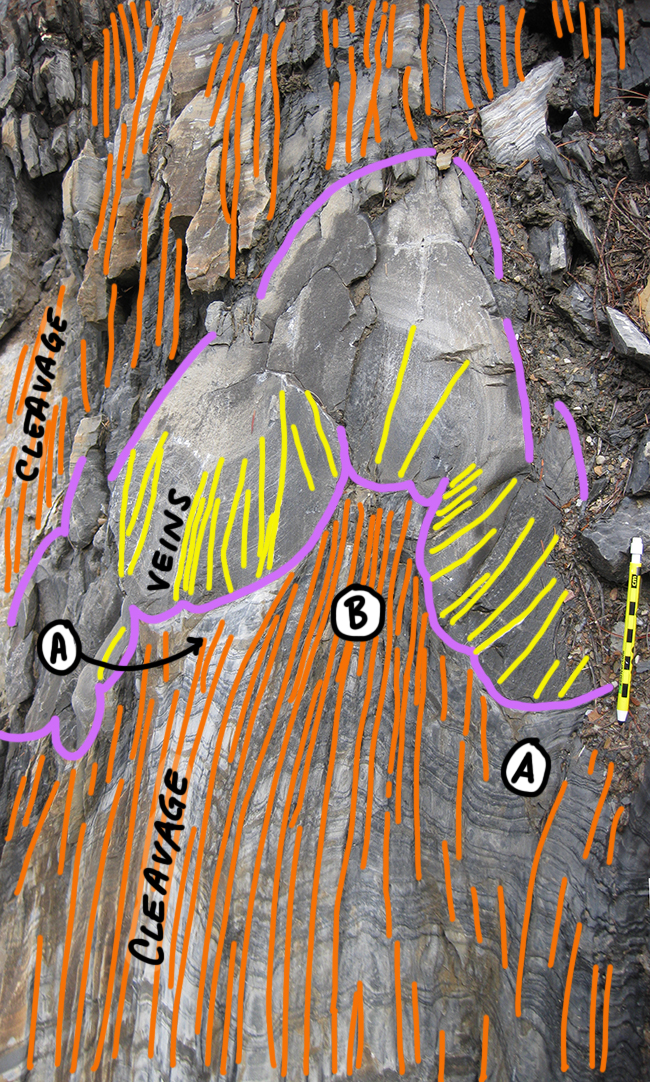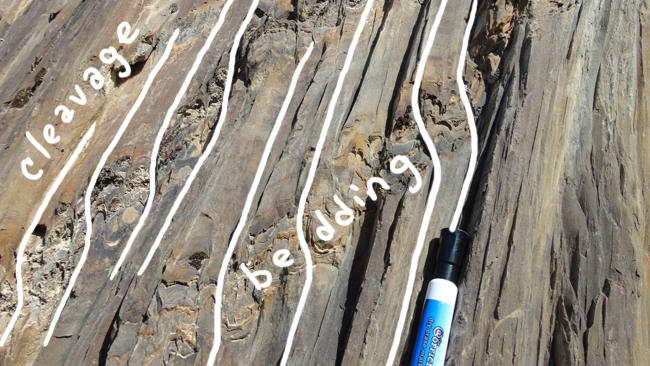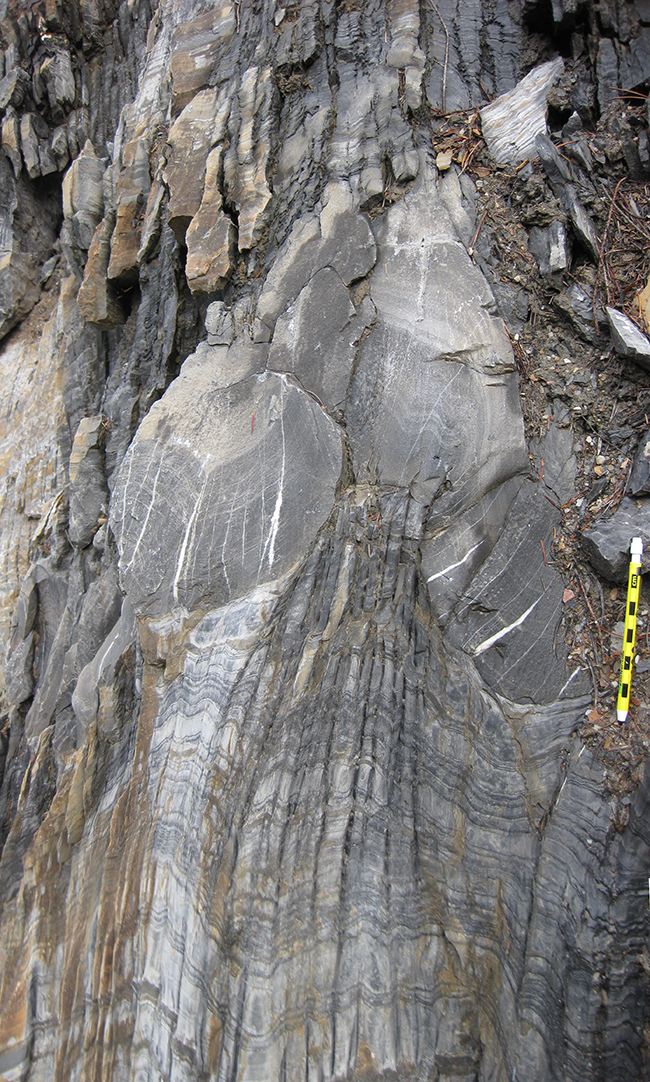8 August 2014
Friday fold: Buckle vs. passive folding in the Chancellor Group slates
Posted by Callan Bentley
I reckon it’s time for me to start processing some of the new images I collected this summer, and sharing them here on the blog. I saw some great new rocks over the past month in the Canadian Rockies, and I’m looking forward to sharing them with you. Here’s a really sweet one to start us off…
That’s an excellent example showcasing the differences between buckle folding and passive folding. Buckle folding is the result when you have a relatively stiff layer between two weak layers. Passive folding results when pressure solution decreases the volume of a rock in a systematic way (imparting cleavage) and sedimentary layers passively change shape as both they and their surrounding matrix are shortened through volume loss.
The rock shown here is “slate” of the Chancellor Group, a limy mudrock-dominated package in the western main ranges of the Canadian Rockies. This particular outcrop is in Yoho National Park, on the road to Natural Bridge. It includes a few coarser layers, too, and then the whole package was squeezed intensely during the orogeny that built the Canadian Rockies (what they refer to as the Laramide Orogeny, though that term would carry a different meaning south of the border). The cleavage (orange lines in the annotation below) was imparted during this tectonism.

Note how the muddy layers are strongly cleaved, implying volume loss through pressure solution. The cleavage is a “spaced” variety, which essentially equates (in my mind) to planar stylolites (i.e., lacking wiggles like classic stylolites). The coarser layer (outlined in purple) exhibits a different sort of strain, however. It’s buckled, implying it was stiffer than the mudrock above and below when it got compressed. Note the cuspate/lobate margins of this unit – this style is typical of buckle folding, as well as the pronounced difference in its cleavage development. Note how the cleavage of the underlying mudrock/slate flares out in the regions marked “A” (below the big synformal lobes of the stiff, coarse bed), and converges inward in the region marked “B” (below the big antiformal cusp below the stiff, coarse bed). Also note the extensional veins that extend up into the stiff, coarse layer. These appear to flare out from the base of the stiff layer’s lobes, in a sort of outer arc extension of the fold.
This was an exquisite outcrop.
I GigaPanned it, too. See if you can find the portion of the outcrop we’ve been discussing in this blog post within the larger context of the outcrop where it’s located (on the road from the Trans-Canada highway west of Field toward Emerald Lake and Natural Bridge):
There’s a lot of passive folding to be seen there. Buckle folding is less common. If you like bedding / cleavage relationships, this is a great outcrop to visit.


Here’s a second GigaPan, to show the passive folding of bedding with well-developed cleavage, and weathering along that cleavage plane:
And, while we’re at it, here’s a nice example of the folding of a sandy layer within the Chancellor that was featured as a previous Friday Fold.
Here, the advantage is provided by another sandy layer, which exhibits buckle folding (as well as cleavage refraction):


Enjoy poking around in these virtual outcrops until you find the folds you’re looking for!
Happy Friday.
The new GigaPans in this post were made on an expedition following my Canadian Rockies field course, and supported by NSF grant DUE- 1323283.



 Callan Bentley is Associate Professor of Geology at Piedmont Virginia Community College in Charlottesville, Virginia. He is a Fellow of the Geological Society of America. For his work on this blog, the National Association of Geoscience Teachers recognized him with the James Shea Award. He has also won the Outstanding Faculty Award from the State Council on Higher Education in Virginia, and the Biggs Award for Excellence in Geoscience Teaching from the Geoscience Education Division of the Geological Society of America. In previous years, Callan served as a contributing editor at EARTH magazine, President of the Geological Society of Washington and President the Geo2YC division of NAGT.
Callan Bentley is Associate Professor of Geology at Piedmont Virginia Community College in Charlottesville, Virginia. He is a Fellow of the Geological Society of America. For his work on this blog, the National Association of Geoscience Teachers recognized him with the James Shea Award. He has also won the Outstanding Faculty Award from the State Council on Higher Education in Virginia, and the Biggs Award for Excellence in Geoscience Teaching from the Geoscience Education Division of the Geological Society of America. In previous years, Callan served as a contributing editor at EARTH magazine, President of the Geological Society of Washington and President the Geo2YC division of NAGT.
I really like this post, it’s my first time hearing about buckle folding.
I really enjoyed this blog, even I started my own blog because of “Mountain Beltway”.
well…I stuck after my second post, but I’ll post the third one hopefully soon
Happy Friday from Indonesia